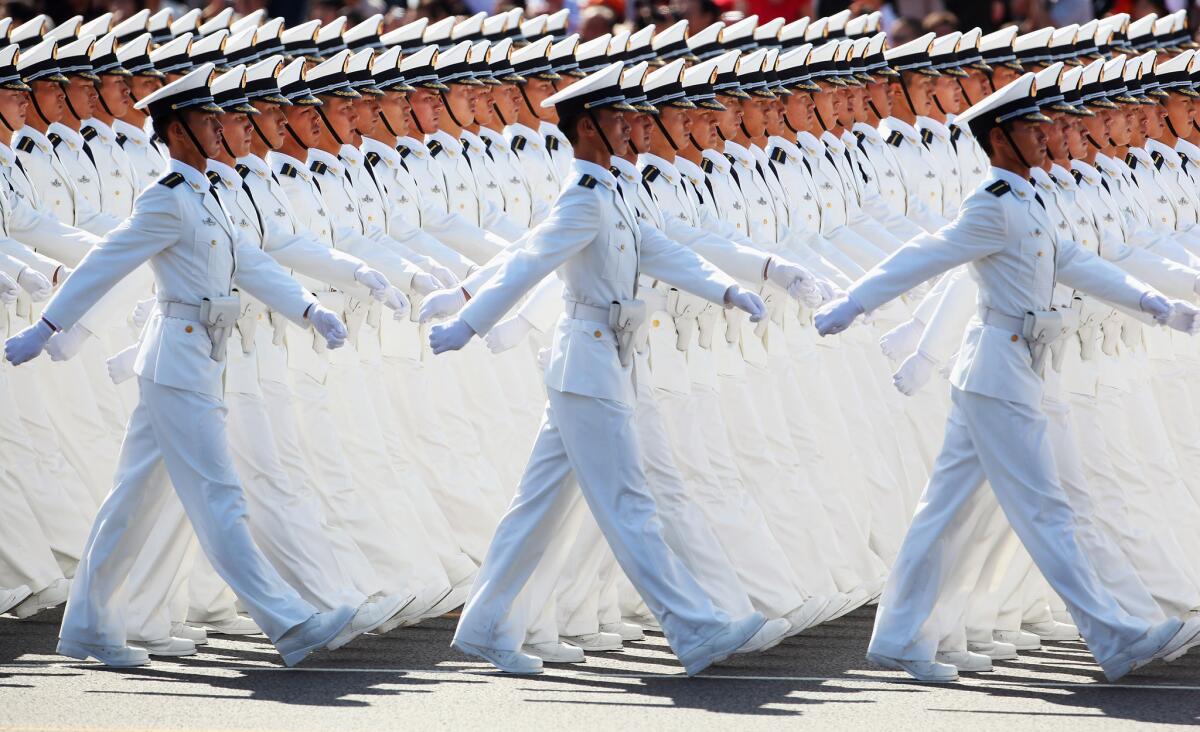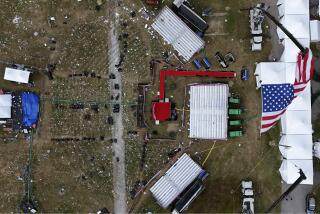China is rattling nerves as it prepares to strut its military might

In a 2009 file photo, Chinese People’s Liberation Army sailors march pass Tiananmen Square during the celebration of the 60th anniversary of the founding of the People’s Republic of China.
Reporting from Beijing — Amid florid pomp and extreme security measures, China on Thursday will mark the 70th anniversary of the end of World War II by staging a massive parade featuring tanks, aircraft and thousands of goose-stepping soldiers.
Chinese leaders say the spectacle is intended to “remember history and uphold peace,” but the weaponry display is already adding to grave concerns in the United States — as well as in Japan, Vietnam, the Philippines and elsewhere — about China’s military capabilities and intentions.
The extravagant military display comes as China has more than doubled its published annual defense budget and projected its growing armed forces’ capabilities further from home with increasing assertiveness under the leadership of President Xi Jinping, particularly at sea. This year alone, it has built artificial islands in the South China Sea, held a joint live-fire naval drill with Russia in the Mediterranean and sent its navy to evacuate hundreds of Chinese citizens from war-torn Yemen.
See the most-read stories this hour >>
According to Chinese state media reports, 84% of the armaments featured in the parade — including 500 pieces of hardware and 200 aircraft — have never been seen by the public. The parade also will feature 12,000 troops.
“What we’re seeing in the parade is the product of three decades of intense military investment: tanks, armored personnel carriers, combat aircraft and missiles. All are the product of an intense military modernization and buildup,” said Richard Fisher, a senior fellow at the Virginia-based International Assessment and Strategy Center who has been monitoring parade rehearsals.
“The parade offers some very clear illustrations that China is winning the arms race with the United States. China’s military challenge is now putting real pressure on America’s military forces in Asia and is continuing to make modernization leaps that [the] U.S. has not begun to respond to.”
Despite claims in state media, Western analysts are aware of most, if not all, of the systems on display. Yet what’s new is China’s willingness to exhibit them, especially in the context of Communist-run China’s first parade dedicated to celebrating China’s defeat of foreign powers.
NEWSLETTER: Get the day’s top headlines from Times Editor Davan Maharaj >>
“China is reminding the United States and Japan of the potential risk and cost of pursuing antagonistic policies,” said Timothy Heath, a senior international defense research analyst at Rand Corp. “And in this political context, with China engulfed in disputes with many foreign powers over the South China Sea, East China Sea, with the U.S. over cyberspace, it carries a more ominous undertone, a more unsettling undertone than the National Day parades.”
China typically has staged a large military parade through Tiananmen Square on every 10th anniversary of the founding of Communist China; the last event, in October 2009 under President Hu Jintao, showed off Chinese-made fighter jets, missiles and other hardware.
Of particular concern now, say U.S. defense experts, are China’s J-20 and J-31 stealth aircraft, as well as the DF-26 intermediate range ballistic missile, which Chinese Internet users have dubbed “the Guam Express.” It could reach the increasingly large numbers of troops the U.S. is putting on the Pacific island as part of its “pivot” to Asia strategy.
“The optics may play well for a domestic audience already primed to hate Japan,” Heath said. “However, the United States and the region are likely to see this as an unsettling development.”
China has increased its stated military budgets by more than 10% annually for the past five years. Beijing, which said it spent about $70 billion on its military in 2009, will spend around $145 billion this year, or about 2.1% of gross domestic product. By comparison, the Pentagon’s published 2015 budget is $560 billion, equal to about 3.1% of America’s GDP — down from a peak of more than $760 billion during the height of the Iraq war.
“By 2020, the equipment of the Chinese military will look a lot like the U.S. military did in 2000. … They really won’t be that far behind us in terms of equipment,” said Roger Cliff, author of the forthcoming book “China’s Military Power: Assessing Current and Future Capabilities.”
Still, he said, China’s military has a “fundamental weakness” — namely a mismatch between its very rigid organizational culture and its equipment. “They are acquiring all the material and obvious sorts of nonmaterial factors that go into an effective military,” he said, “but they don’t have the organization or the culture they would need to actually become one.”
China has about 2.3 million active-duty troops, according to a 2014 assessment by the London-based International Institute for Strategic Studies. Although the vast majority of those are land-based forces, China is trying to boost the number of sailors and airmen in its ranks, said Xu Guangyu, a retired Chinese military officer and consultant to the China Arms Control and Disarmament Assn.
Chinese analysts and state media reports have said that authorities are staging the parade partly because they feel that China’s contributions to World War II — and its sufferings — have never been sufficiently recognized by the rest of the world.
China, Xu said, is “not showing off” and is “not trying to scare the U.S., Japan, the Philippines or anyone. There is still a big gap between China’s hardware and capabilities and those of advanced countries like the U.S.”
The parade, he said, is intended to promote Chinese unity and “show that we are addressing our security needs at a reasonable level.” He added that China is increasingly engaged in international security efforts such as anti-pirate patrols.
But foreign analysts say China’s new generation of military hardware is by no means purely defensive.
Since the late 1990s, while the U.S. focused on wars in places like Serbia, Iraq and Afghanistan, China has been studying how Washington fights — in particular, relying on precision-guided munitions and building up forces near the theater — then developing strategies and equipment that could take advantage of American weaknesses to keep U.S. troops at bay.
Chinese forces have acquired numerous inexpensive but deadly short- and medium-range ballistic missiles, as well as anti-ship cruise missiles, and have invested deeply in a submarine-building program that has been much more productive than Pentagon officials anticipated, said Scott Harold, deputy director of Rand Corp.’s Center for Asia-Pacific Policy.
China, he said, is trying to “make it very lethal” for anyone to enter disputed maritime territory that it lays claim to in the East and South China Seas.
In planning for conflict in Asia, China has a large home-court advantage. While China’s logistical supply lines are on shore, the U.S. must project power all the way across the Pacific, from places thousands of miles away, including the U.S. West Coast, Alaska, Hawaii, Guam and bases in Japan.
And because the primary U.S. conflicts over the past 15 to 20 years have primarily involved enemies without sophisticated air defenses and the ability to launch long-range aerial attacks, Washington has not prioritized weapons systems to deal with China’s new capabilities, Harold said.
In its 2015 report to Congress on China’s military power, the Pentagon warned that China is “rapidly closing the gap with Western air forces across a broad spectrum of capabilities,” including aircraft, command-and-control systems, jammers, electronic warfare and data links. China’s armed forces’ modernization, it said, “has the potential to reduce core U.S. military technological advantages.”
Harold and other experts noted that Beijing won’t, or can’t, put the country’s most worrisome military capabilities on parade.
“China’s space warfare capabilities will not be on display; its vast cyberwarfare capabilities can’t be represented in a parade display. … Nuclear-powered attack submarines will not be on display,” he said.
The U.S. and other governments have on one hand been seeking greater engagement with China’s military. Washington and Beijing have, in recent years, been expanding military-to-military exchanges.
But distrust and suspicion between Beijing and Washington — not to mention Japan and the Philippines — shows little sign of abating anytime soon. Washington is actively trying to mobilize its allies in the region and help beef up their means of countering China’s new capabilities.
Heath predicted that the parade would further strain U.S.-China relations ahead of Xi’s planned state visit to Washington later this month.
“A parade designed to humiliate a vital U.S. ally [Japan] and that prominently features weapons systems designed to target U.S. forces will sour the atmosphere before the summit,” he said.
Already, numerous GOP presidential candidates are calling on President Obama to downgrade Xi’s visit or cancel it altogether. But the declining U.S. support for strong relations with China goes beyond campaign politics, Heath believes.
“The administration is already signaling a harder line. … Relations between the first and second largest economies in the world appear headed toward heightened tension.”
Times staff writer Jonathan Kaiman and Nicole Liu in the Times’ Beijing bureau contributed to this report.
Follow @JulieMakLAT for news from China
ALSO:
244 immigrants arrested in four-day sweep across Southern California
China and Russia are using hacked data to target U.S. spies, officials say
This is climate change: Alaskan villagers struggle as island is chewed up by the sea
More to Read
Sign up for Essential California
The most important California stories and recommendations in your inbox every morning.
You may occasionally receive promotional content from the Los Angeles Times.











